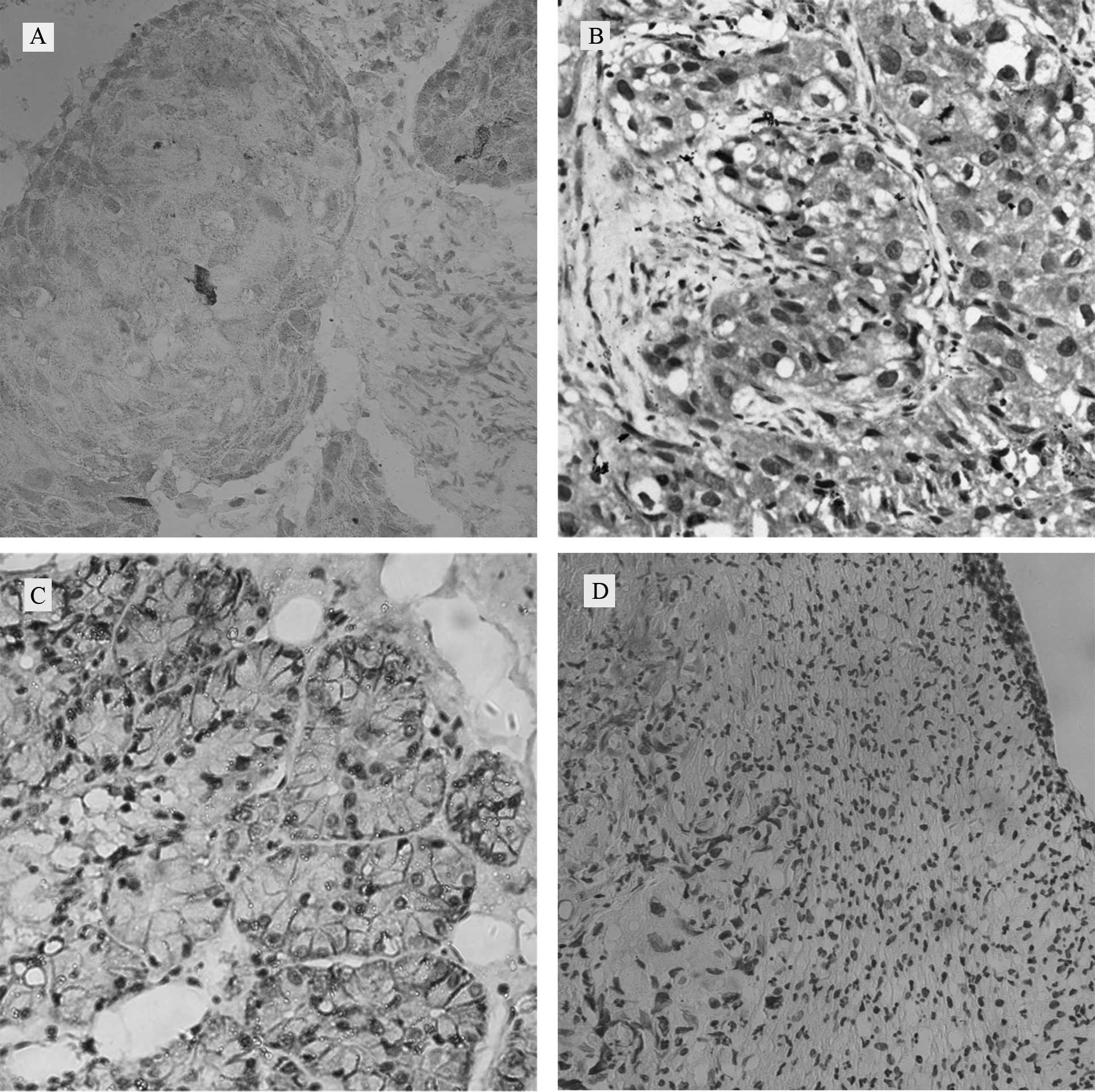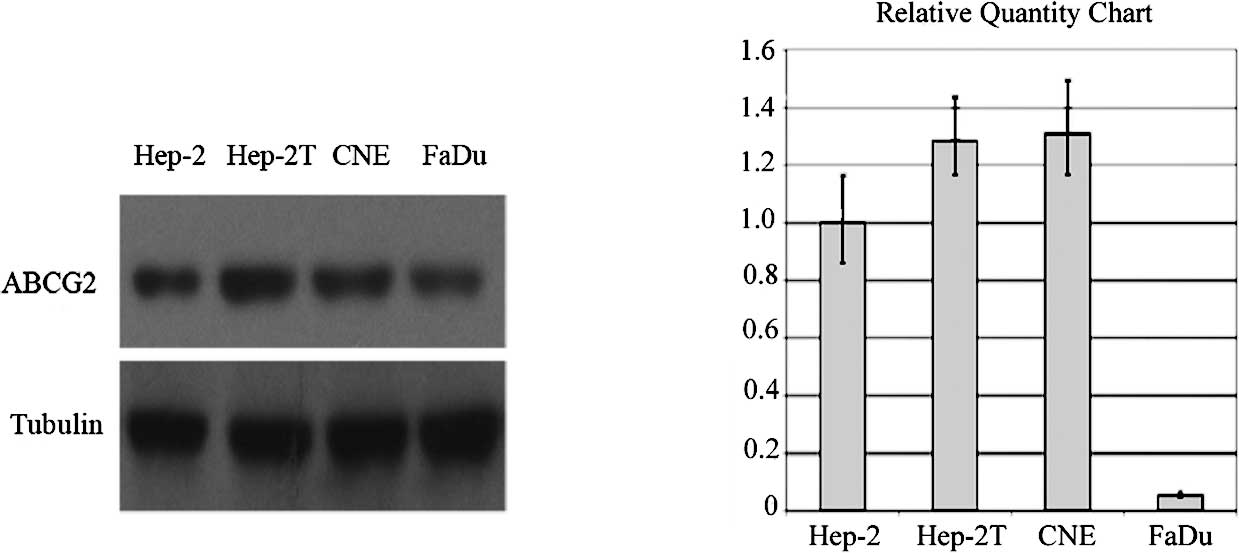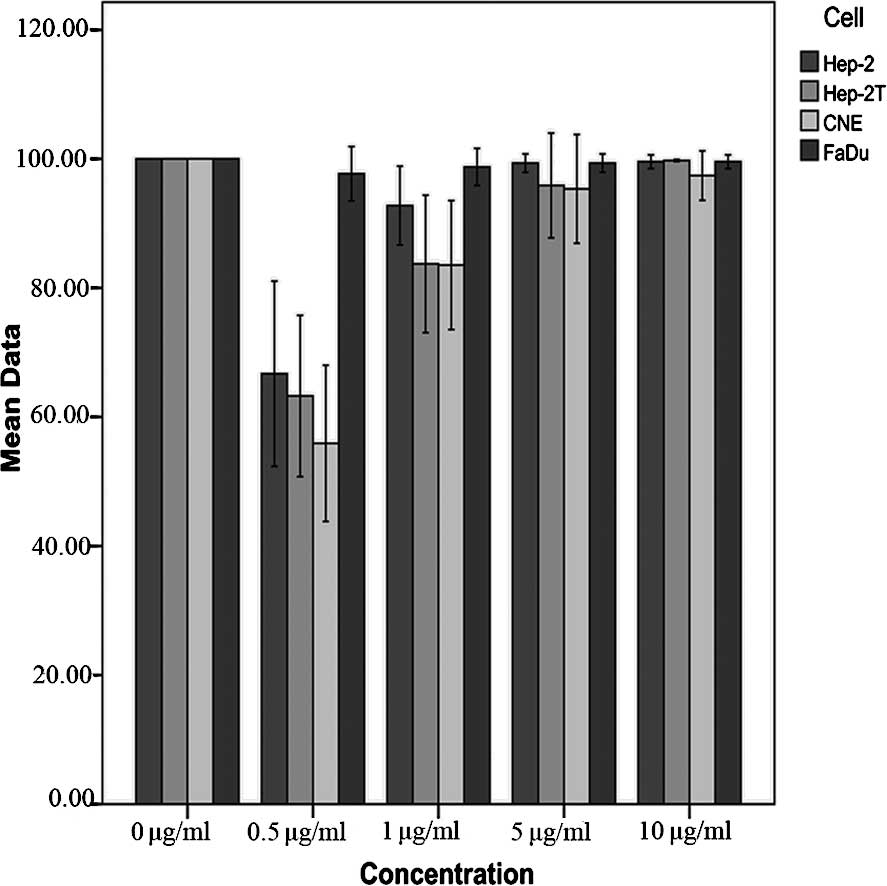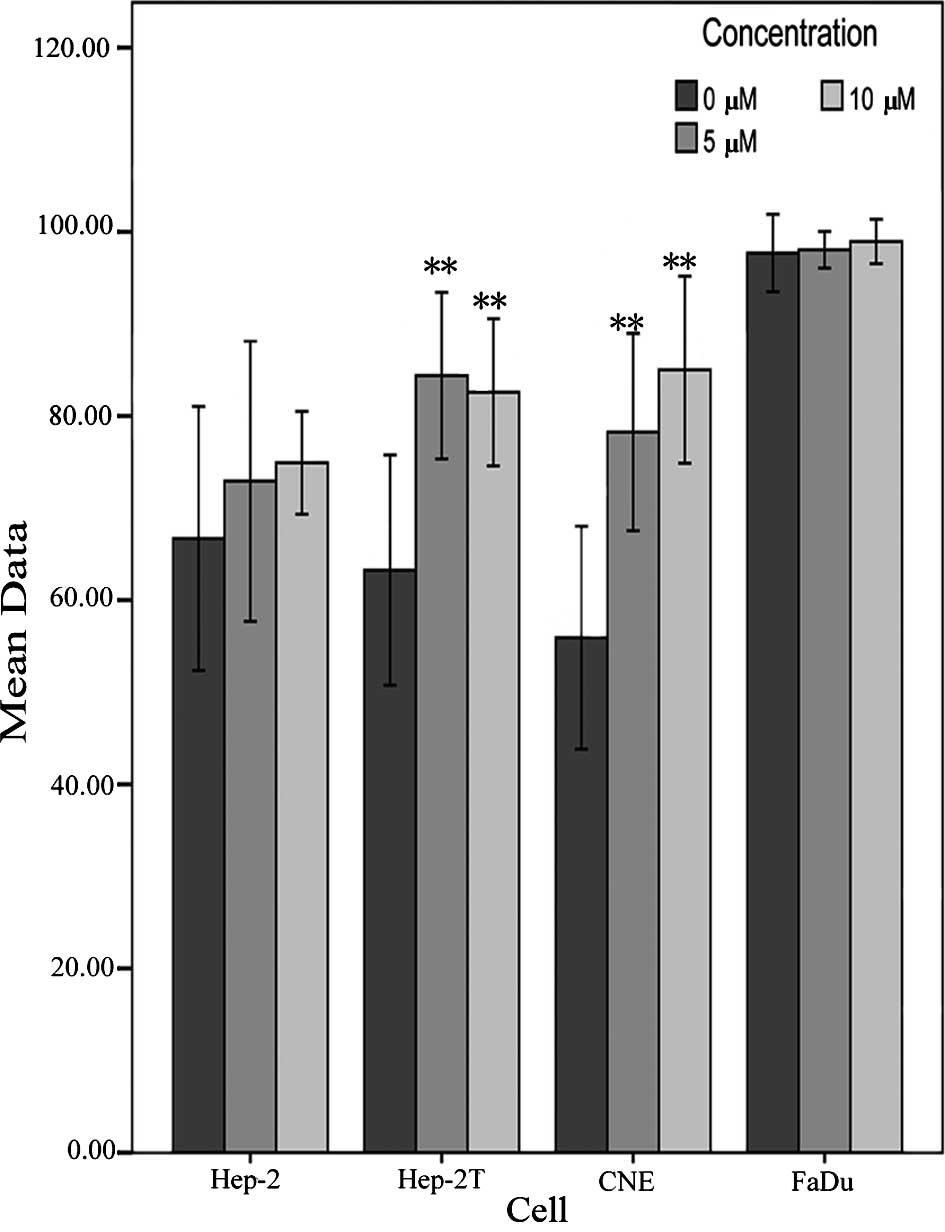|
1
|
Greenlee RT, Murray T, Bolden S and Wingo
PA: Cancer statistics, 2000. CA Cancer J Clin. 50:7–33. 2000.
View Article : Google Scholar
|
|
2
|
Vokes EE, Weichselbaum RR, Lippman SM and
Hong WK: Head and neck cancer. N Engl J Med. 328:184–194. 1993.
View Article : Google Scholar : PubMed/NCBI
|
|
3
|
Clark JI, Hofmeister C, Choudhury A, et
al: Phase II evaluation of paclitaxel in combination with
carboplatin in advanced head and neck carcinoma. Cancer.
92:2334–2340. 2001. View Article : Google Scholar : PubMed/NCBI
|
|
4
|
Dean M, Hamon Y and Chimini G: The human
ATP-binding cassette (ABC) transporter superfamily. J Lipid Res.
42:1007–1017. 2001.PubMed/NCBI
|
|
5
|
Ross DD and Nakanishi T: Impact of breast
cancer resistance protein on cancer treatment outcomes. Methods Mol
Biol. 596:251–290. 2010. View Article : Google Scholar : PubMed/NCBI
|
|
6
|
Doyle LA, Yang W, Abruzzo LV, et al: A
multidrug resistance transporter from human MCF-7 breast cancer
cells. Proc Natl Acad Sci USA. 95:15665–15670. 1998. View Article : Google Scholar : PubMed/NCBI
|
|
7
|
Diestra JE, Condom E, del Muro XG, et al:
Expression of multidrug resistance proteins P-glycoprotein,
multidrug resistance protein 1, breast cancer resistance protein
and lung resistance-related protein in locally advanced bladder
cancer treated with neoadjuvant chemotherapy: biological and
clinical implications. J Urol. 170:1383–1387. 2003.
|
|
8
|
Sauerbrey A, Sell W, Steinbach D, Voigt A
and Zintl F: Expression of the BCRP gene (ABCG2/MXR/ABCP) in
childhood acute lymphoblastic leukaemia. Br J Haematol.
118:147–150. 2002. View Article : Google Scholar : PubMed/NCBI
|
|
9
|
Abbott BL, Colapietro AM, Barnes Y, Marini
F, Andreeff M and Sorrentino BP: Low levels of ABCG2 expression in
adult AML blast samples. Blood. 100:4594–4601. 2002. View Article : Google Scholar : PubMed/NCBI
|
|
10
|
Plasschaert SL, van der Kolk DM, de Bont
ES, et al: The role of breast cancer resistance protein in acute
lymphoblastic leukemia. Clin Cancer Res. 9:5171–5177.
2003.PubMed/NCBI
|
|
11
|
Benderra Z, Faussat AM, Sayada L, et al:
Breast cancer resistance protein and P-glycoprotein in 149 adult
acute myeloid leukemias. Clin Cancer Res. 10:7896–7902. 2004.
View Article : Google Scholar : PubMed/NCBI
|
|
12
|
Nakayama K, Kanzaki A, Ogawa K, Miyazaki
K, Neamati N and Takebayashi Y: Copper-transporting P-type
adenosine triphosphatase (ATP7B) as a cisplatin-based
chemoresistance marker in ovarian carcinoma: comparative analysis
with expression of MDR1, MRP1, MRP2, LRP and BCRP. Int J Cancer.
101:488–495. 2002. View Article : Google Scholar
|
|
13
|
Faneyte IF, Kristel PM, Maliepaard M, et
al: Expression of the breast cancer resistance protein in breast
cancer. Clin Cancer Res. 8:1068–1074. 2002.PubMed/NCBI
|
|
14
|
Tsunoda S, Okumura T, Ito T, et al: ABCG2
expression is an independent unfavorable prognostic factor in
esophageal squamous cell carcinoma. Oncology. 71:251–258. 2007.
View Article : Google Scholar : PubMed/NCBI
|
|
15
|
Yoh K, Ishii G, Yokose T, et al: Breast
cancer resistance protein impacts clinical outcome in
platinum-based chemotherapy for advanced non-small cell lung
cancer. Clin Cancer Res. 10:1691–1697. 2004. View Article : Google Scholar : PubMed/NCBI
|
|
16
|
Jin Y, Bin ZQ, Qiang H, et al: ABCG2 is
related with the grade of glioma and resistance to mitoxantone, a
chemotherapeutic drug for glioma. J Cancer Res Clin Oncol.
135:1369–1376. 2009. View Article : Google Scholar : PubMed/NCBI
|
|
17
|
Polgar O, Robey RW and Bates SE: ABCG2:
structure, function and role in drug response. Expert Opin Drug
Metab Toxicol. 4:1–15. 2008. View Article : Google Scholar : PubMed/NCBI
|
|
18
|
Honjo Y, Hrycyna CA, Yan QW, et al:
Acquired mutations in the MXR/BCRP/ABCP gene alter substrate
specificity in MXR/BCRP/ABCP-overexpressing cells. Cancer Res.
61:6635–6639. 2001.PubMed/NCBI
|
|
19
|
Robey RW, Honjo Y, Morisaki K, et al:
Mutations at amino-acid 482 in the ABCG2 gene affect substrate and
antagonist specificity. Br J Cancer. 89:1971–1978. 2003. View Article : Google Scholar : PubMed/NCBI
|
|
20
|
Ejendal KFK, Diop NK, Schweiger LC and
Hrycyna CA: The nature of amino acid 482 of human ABCG2 affects
substrate transport and ATP hydrolysis but not substrate binding.
Protein Sci. 15:1597–1607. 2006. View Article : Google Scholar : PubMed/NCBI
|
|
21
|
Miwa M, Tsukahara S, Ishikawa E, Asada S,
Imai Y and Sugimoto Y: Single amino acid substitutions in the
transmembrane domains of breast cancer resistance protein (BCRP)
alter cross resistance patterns in transfectants. Int J Cancer.
107:757–763. 2003. View Article : Google Scholar
|
|
22
|
Song J, Chang I, Chen Z, Kang M and Wang
CY: Characterization of side populations in HNSCC: highly invasive,
chemoresistant and abnormal Wnt signaling. PloS One. 5:e114562010.
View Article : Google Scholar : PubMed/NCBI
|
|
23
|
Schwabedissen HE and Kroemer HK: In vitro
and in vivo evidence for the importance of breast cancer resistance
protein transporters (BCRP/MXR/ABCP/ABCG2). Handb Exp Pharmacol.
201:325–371. 2011. View Article : Google Scholar : PubMed/NCBI
|
|
24
|
Li L, Jiang AC, Dong P, Wan Y and Yu ZW:
The characteristics of Hep-2 cells with multiple drug resistance
induced by Taxol. Otolaryngol Head Neck Surg. 137:659–664. 2007.
View Article : Google Scholar : PubMed/NCBI
|
|
25
|
Allen JD, van Loevezijn A, Lakhai JM, et
al: Potent and specific inhibition of the breast cancer resistance
protein multidrug transporter in vitro and in mouse intestine by a
novel analogue of fumitremorgin C. Mol Cancer Ther. 1:417–425.
2002.
|
|
26
|
Robey RW, To KK, Polgar O, et al: ABCG2: a
perspective. Adv Drug Deliv Rev. 61:3–13. 2009. View Article : Google Scholar
|
|
27
|
Benderra Z, Faussat AM, Sayada L, et al:
MRP3, BCRP, and P-glycoprotein activities are prognostic factors in
adult acute myeloid leukemia. Clin Cancer Res. 11:7764–7772. 2005.
View Article : Google Scholar : PubMed/NCBI
|
|
28
|
Uggla B, Stahl E, Wagsater D, et al: BCRP
mRNA expression v. clinical outcome in 40 adult AML patients. Leuk
Res. 29:141–146. 2005. View Article : Google Scholar : PubMed/NCBI
|
|
29
|
Suvannasankha A, Minderman H, O'Loughlin
KL, et al: Breast cancer resistance protein (BCRP/MXR/ABCG2) in
acute myeloid leukemia: discordance between expression and
function. Leukemia. 18:1252–1257. 2004. View Article : Google Scholar : PubMed/NCBI
|
|
30
|
Sawyers CL: The cancer biomarker problem.
Nature. 452:548–552. 2008. View Article : Google Scholar : PubMed/NCBI
|
|
31
|
Maliepaard M, Scheffer GL, Faneyte IF, et
al: Subcellular localization and distribution of the breast cancer
resistance protein transporter in normal human tissues. Cancer Res.
61:3458–3464. 2001.PubMed/NCBI
|
|
32
|
Young LC, Campling BG, Cole SPC, Deeley RG
and Gerlach JH: Multidrug resistance proteins MRP3, MRP1, and MRP2
in lung cancer: correlation of protein levels with drug response
and messenger RNA levels. Clin Cancer Res. 7:1798–1804.
2001.PubMed/NCBI
|
|
33
|
Hirschmann-Jax C, Foster AE, Wulf GG, et
al: A distinct ‘side population’ of cells with high drug efflux
capacity in human tumor cells. Proc Natl Acad Sci USA.
101:14228–14233. 2004.
|
|
34
|
Haraguchi N, Utsunomiya T, Inoue H, et al:
Characterization of a side population of cancer cells from human
gastrointestinal system. Stem Cells. 24:506–513. 2006. View Article : Google Scholar : PubMed/NCBI
|


















